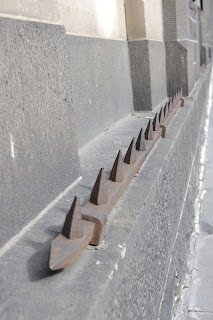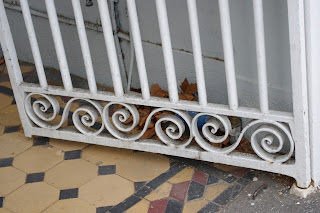Site 20
375 Queen St
Loiter prevention device
A documentation of hand forged ironwork visible in the streets of Melbourne CBD. The geographical parameters of the survey are all the streets and lanes within Spring, Flinders, Spencer, Hawke and Victoria Streets. I'm aware of the makers of a few of the pieces but most are maker unknown.
Saturday 25 August 2012
Friday 24 August 2012
Thursday 16 August 2012
Sunday 12 August 2012
Site 2
Royal Melbourne Regiment Building. 53 Victoria St
Doors to courtyard entrance and window above door opening. Hooks on either side of goods access gates. These works are simple security devices to separate the public outside on the street from members and associates of the Regiment within. The forged doors are today fixed open permanently.
I am conducting a survey of hand made ironwork in the City of Melbourne as a component of my research project for MA (Art in Public Space) at RMIT University.
The geographical parameters are Flinders St, Spring St, Victoria St, Hawke St and Spencer St.
All streets and laneways which fall within these boundaries will be included in the survey.
While interested particularly in the handmade, I'm looking only at works which can be seen from the street and are forged iron or steel.
Site 1.
City Baths. Victoria St.
This site is a typical cast iron fence assembly with forged iron buttressing, gate styles and drop bolts. The fence and gates separate public street space with a public venue which requires the payment of an entrance fee.
The geographical parameters are Flinders St, Spring St, Victoria St, Hawke St and Spencer St.
All streets and laneways which fall within these boundaries will be included in the survey.
While interested particularly in the handmade, I'm looking only at works which can be seen from the street and are forged iron or steel.
Site 1.
City Baths. Victoria St.
This site is a typical cast iron fence assembly with forged iron buttressing, gate styles and drop bolts. The fence and gates separate public street space with a public venue which requires the payment of an entrance fee.
Subscribe to:
Posts (Atom)






















































